Cubing club arranges mosaic of Gautama Buddha using 1500 cubes!

The brilliant minds at the SRM AP cubing club have proved themselves again. On the occasion of Buddha Purnima, a group of students from the Cubing Club came together to arrange a mosaic of Gautama Buddha using 1500 cubes! A project of this magnitude usually takes a couple of weeks to be completed, but our students were able to complete the design within five days.
The smart brains behind this artistic endeavour:
Tarun Vaka
Jyothi Madem
Kota Vasu Desik
Durga Surya Teja Indigimilli
Sri Sathya Sai Karthik Kongara
Venkata Mohit Simhadri
Divyambica Satya Vasa
Lolugu Charansai Venkatanarayana
The vibrant colours and the simplicity behind the mosaic portray the Buddha’s teachings and the elementary life he led on earth. Members of cubing club received appreciations from peers, faculty members and university leadership in creating this adroit artistic masterpiece.
- Published in Clubs and Societies, Departmental News, News, student affairs news, Students Achievements
PAN/PVP blend nanofiber air filtration mechanism
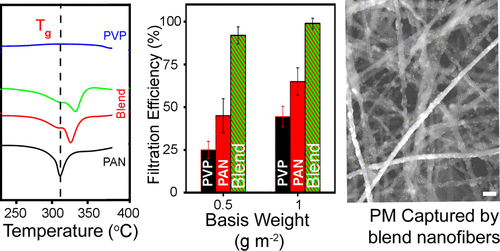
Studies and research on air pollution have sparked worldwide interest in the recent decades to overcome the imminent threat of air pollution. The air filtration mechanism is one of the efficient ways to capture particulate matter (PM) and purify the air. An innovatory air filtration mechanism blending polyacrylonitrile (PAN)/polyvinylpyrrolidone (PVP) polymer nanofibers has been proposed by Prof Ranjit Thapa and his PhD scholar Deepak S Gavali from the Department of Physics.
The paper “Low Basis Weight Polyacrylonitrile/Polyvinylpyrrolidone Blended Nanofiber Membranes for Efficient Particulate Matter Capture” was published in collaboration with Applied NanoPhysics Laboratory, Department of Physics and Nanotechnology, SRM Institute of Science and Technology, Kattankulathur. It was featured in the journal ‘ACS Applied Polymer Materials’ having an Impact Factor of 4.09.
In the twenty-first century, air pollution is a major problem facing human and environmental health. Every year, millions of people die, mostly in developing nations, owing to the aggravating level of air pollution. According to the World Health Organization (WHO), 92 per cent of the people live in places where the air quality level has crossed the WHO limits. Particulate matter (PM) (solid or liquid particles with different aerodynamic diameters), nitrogen dioxide (NO2), ozone (O3), and others are the relevant air contaminants.
In low-income cities, the effect of PM 2.5 pollution is high due to high urban air pollution. Even at very low concentrations, PM 2.5 (particles with an aerodynamic diameter less than 2.5 µm) pollution has health consequences. Air filtration is one of the best remedies to tackle such problems and maintain a clean environment for humans. Among the available air filter materials, fiber-based air filters have proven to be the most potentially effective treatment, due to their high porosity, high surface area, lightweight, etc.
This study relies on a careful design that blends PAN and PVP fibers. The resultant nanofiber material is utilized to overcome the low air pressure resistance issue with high filtration efficiency. Large-scale free-standing nanofibers were obtained by a simple peeling-off process. The morphology, chemical interaction between the filter media and PM pollutant; and filtration properties were investigated. Compared to commercial mask, the semi- high-efficiency particulate air (HEPA) filter media, PAN/PVP filter medium showed superior performance in PM 2.5 filtration. Furthermore, the intermolecular interactions between PMs and nanofibers were analyzed by DFT calculations. With constant optimization of synthesis conditions, the synthesized air filters achieved high filtration efficiency for PM removal and showed great potential for practical application.
Abstract of the Research
Particulate matter (PM) in air frequently poses a serious threat to human health. Smaller PM can easily enter into the alveolus and blood vessels with airflow. This work reports the first polyacrylonitrile (PAN)/polyvinylpyrrolidone (PVP) polymer blend nanofiber filter media for effectively capturing PM. Density functional theory (DFT) calculations are used to investigate the effect of the blending of two polymers on the dipole moment and the electrostatic potential. Based on the DFT calculations of the intermolecular interactions between nanofibers and PM, the PAN/PVP heteromolecular percentage is considered for experimental synthesis, which can provide better performance in the filtration of pollutants. The composite PAN/PVP fiber network was successfully developed and optimized to cope with complex environments during the actual filtration process. The role of the blending ratio of PAN and PVP in wt % was explored on PM 2.5 capture, and the refined ratio overcame the conflict between high filtration efficiency and low air pressure resistance. The air filter medium PAN/PVP (6:2) possesses an extremely high air filtration efficiency of 92% under a very low pressure drop of 18 Pa for a 0.5 g m–2 basis weight. Both polar and nonpolar functional groups in blend nanofibers promoted significantly the electrostatic attraction and improved the filtration efficiency under static and dynamic airflow. The PAN/PVP nanofiber membranes maintain outstanding air filtration under different temperature and humidity conditions. This study will shed light on the fabrication of high-efficiency low-basis weight nanofiber filter media as an end product.
- Published in Departmental News, News, Physics News, Research News
Dr Sheela Singh secures patent for novel method of engine piston rings
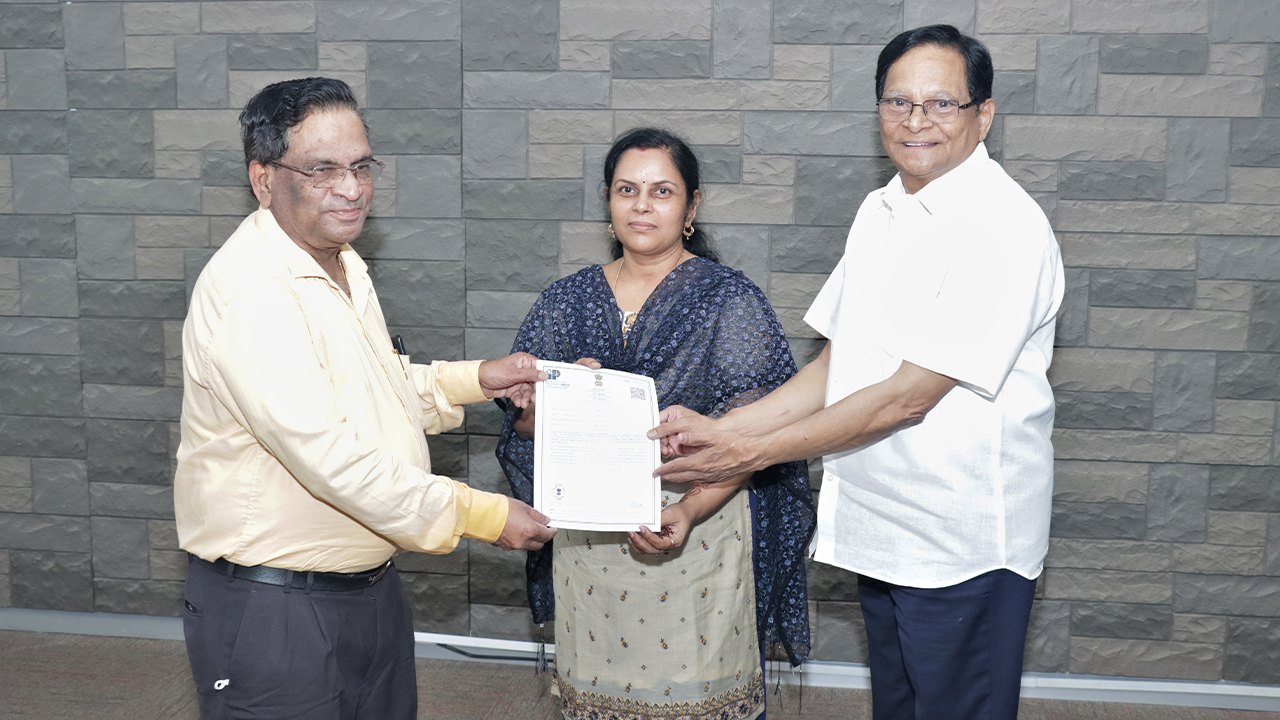
Research at SRM University-AP shows that applying a composite coating of chromium aluminum carbide (CR2 ALC) to the engine piston rings not only improves piston performance but also increases engine life, efficiency and lubrication. The university obtained a patent for the same under the title “NICKEL MOLYBDENUM ALUMINIUM (NIMOAL) – CHROMIUM ALUMINIUM CARBIDE (CR2ALC) MAX PHASE COMPOSITE COATINGS FOR AUTOMOTIVE APPLICATIONS AND A METHOD FOR MAKING THE SAME”.
For any vehicle to run efficiently for a long time, its engine must be good. The rings on piston further improve the engine performance. It is in this context that many efforts are being made by scientists to develop piston rings with the new scientific technologies. Dr Sheela Singh, Associate Professor in the Department of Mechanical Engineering at SRM AP, has been conducting comprehensive research on the subject for three years with research student Deepak Davis.
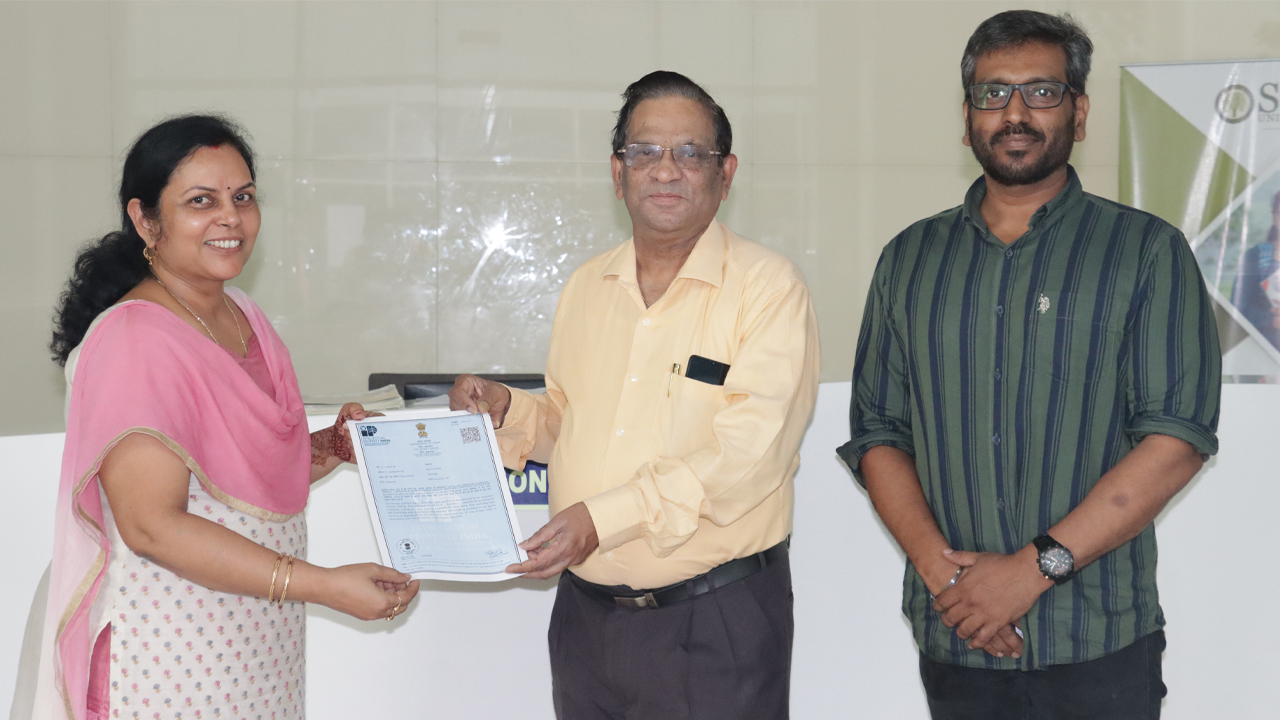
The piston rings of motor vehicles currently on the market have a coating with nickel molybdenum aluminum. SRM University-AP researchers say it would be better to use a composite coating made with chromium aluminum carbide instead. If the piston rings have high velocity and lubrication properties, their rigidity is good and it is better to use chromium aluminum carbide (CR2LC).
The Patent Certificate is issued by the Patent Office, Government of India, after thorough examination. University President Dr Satyanarayanan, Vice-Chancellor Prof V S Rao, Pro Vice-Chancellor Prof D Narayana Rao and others lauded Dr Sheela Singh and Deepak Davis for their fervent research and innovation. This is the second patent granted to SRM University-AP.
- Published in Departmental News, Mechanical Engineering NEWS, News, Research News
Remodelling fan blades to downsize the bird strike impact
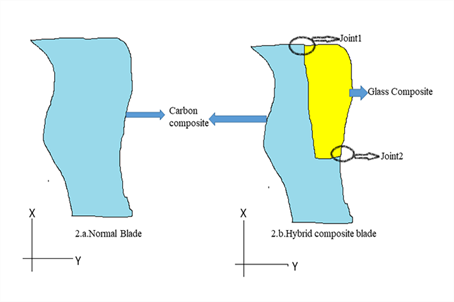 Bird strikes are a crucial phenomenon that should be taken into consideration while designing aircraft. Bird strikes have been reported since the early days of flight causing fatal disasters. It is estimated that around 300 people were killed, and several aircraft were destroyed because of bird strikes. A great deal of research has been conducted to tweak the design of aircraft to bring down the impact of bird strikes. Prof Prakash Jadhav and his PhD scholar Gruhalakshmi Yella from the Department of Mechanical Engineering have published a paper offering an appropriate solution in this regard.
Bird strikes are a crucial phenomenon that should be taken into consideration while designing aircraft. Bird strikes have been reported since the early days of flight causing fatal disasters. It is estimated that around 300 people were killed, and several aircraft were destroyed because of bird strikes. A great deal of research has been conducted to tweak the design of aircraft to bring down the impact of bird strikes. Prof Prakash Jadhav and his PhD scholar Gruhalakshmi Yella from the Department of Mechanical Engineering have published a paper offering an appropriate solution in this regard.
Their paper titled “Hybrid joint interface in composite fan blade subjected to bird strike loading” has been published in the international journal, ‘Proceedings of the Institution of Mechanical Engineers, Part C: Journal of Mechanical Engineering Science’ having an impact factor of 1.76. The research puts forward an ideal solution to alter the design of the aircraft fan blades which are frequently being subjected to such collisions. The duo proposes a hybrid joint interface using two fibres instead of a single fibre.
Some delamination failures observed in the trailing edge of the blades could probably increase the effect of such bird strikes. For rectifying the delamination problem, the proposed solution is to use a material with higher strain capability such as glass fibres in the areas on the fan blade which are prone to delamination, while maintaining carbon material on the remaining blade. The concept is proved by first performing a static analysis on 3D FEA coupons with an in-built hybrid interface joint and next by performing a dynamic bird strike analysis on 3D FEA coupons and sub-element models with an in-built hybrid interface.
Abstract of the Research
Fan blades are one of the most important components of an aircraft engine. Bird strikes on fan blades have always been a cause of worry and it can cause slices of birds to hit other parts of the engine which may lead to greater damage. Bird strikes cannot be completely avoided. Although current composite blades can withstand the bird strike impact, some delamination failures are still observed on the trailing edge side of the blade, possibly due to vibration bending modes. This paper talks about using two fibres in a composite blade instead of the current single fibre one. For this to be feasible, two fibre joints at various locations on the blade must be properly designed. The design criteria used here is the lowest inter-laminar shear strain level at critical joint locations.
- Published in Departmental News, Mechanical Engineering NEWS, News, Research News
DST-SERB international research fellowship for Dr Raviteja
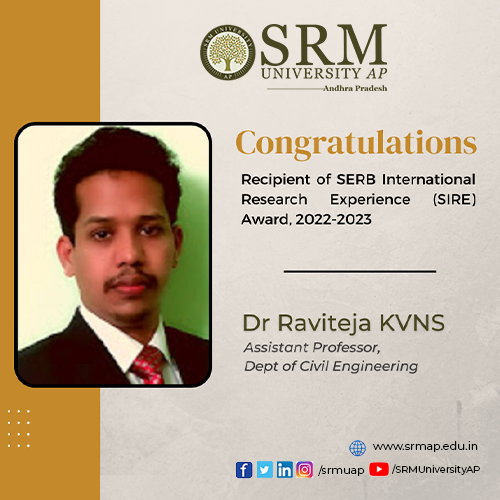
SERB International Research Experience (SIRE) is a coveted opportunity for passionate researchers to collaborate with leading institutions across the globe for high-end research training in frontier areas of Science and Technology. Dr Raviteja from the Department of Civil Engineering has earned this opportunity through his resourceful project titled “Sustainable Ash based Geosynthetic Clay Liners for MSW Landfills”. The work proposes a sustainable design of solid waste landfill liners using industrial by-products like fly ash.
Municipal solid waste (MSW) landfills need to be lined at the bottom to avoid contaminant transport. The conveyance of noxious pollutants from the landfill to the natural ground can be restricted using natural or synthetic barriers. In general, natural materials like clays/bentonites in combination with geomembranes (GMB) are used in liners. However, to increase the strength properties and reduce the compressibility characteristics, bentonites are often mixed with sand. With the increased cost and scarcity of sand, there is a renewed interest among the researchers to identify an alternative material to replace sand proportion in compacted GCLs in MSW landfills. Among several materials, fly ash is proved to be a potential substitute for sand in landfill liners.
This experience will serve as an excellent opportunity to work at one of the world-renowned, state-of-the-art geoenvironmental laboratories at the University of Illinois Chicago. “I feel fortunate to collaborate with Prof. Krishna Reddy, one of the eminent researchers in the geoenvironmental research fraternity. My research at UIC would be on developing sustainable ash-based geosynthetic clay liners for MSW landfills. I also wish to pursue recent advances in this area and identify a framework for my future research”, said Dr Raviteja. The project will help him establish strong research collaborations with experts in the geotechnical labs at other US universities. He can also make field visits to identify the practical problems and direct his research toward the real-field applicability.
With an enriching research exposure at UIC, he will be able to formulate innovative and advanced research problems to enhance the visibility and applicability of his project. Presenting this work at various conferences and seminars will also attract various potential collaborations and MoU with other universities abroad. According to him, “this is a less explored domain that will immensely benefit research scholars and undergraduate students to invent new possibilities and scopes in the future”.
- Published in CIVIL NEWS, Departmental News, Faculty Achievements, News, Research News
Top five winners of the Suggestion contest
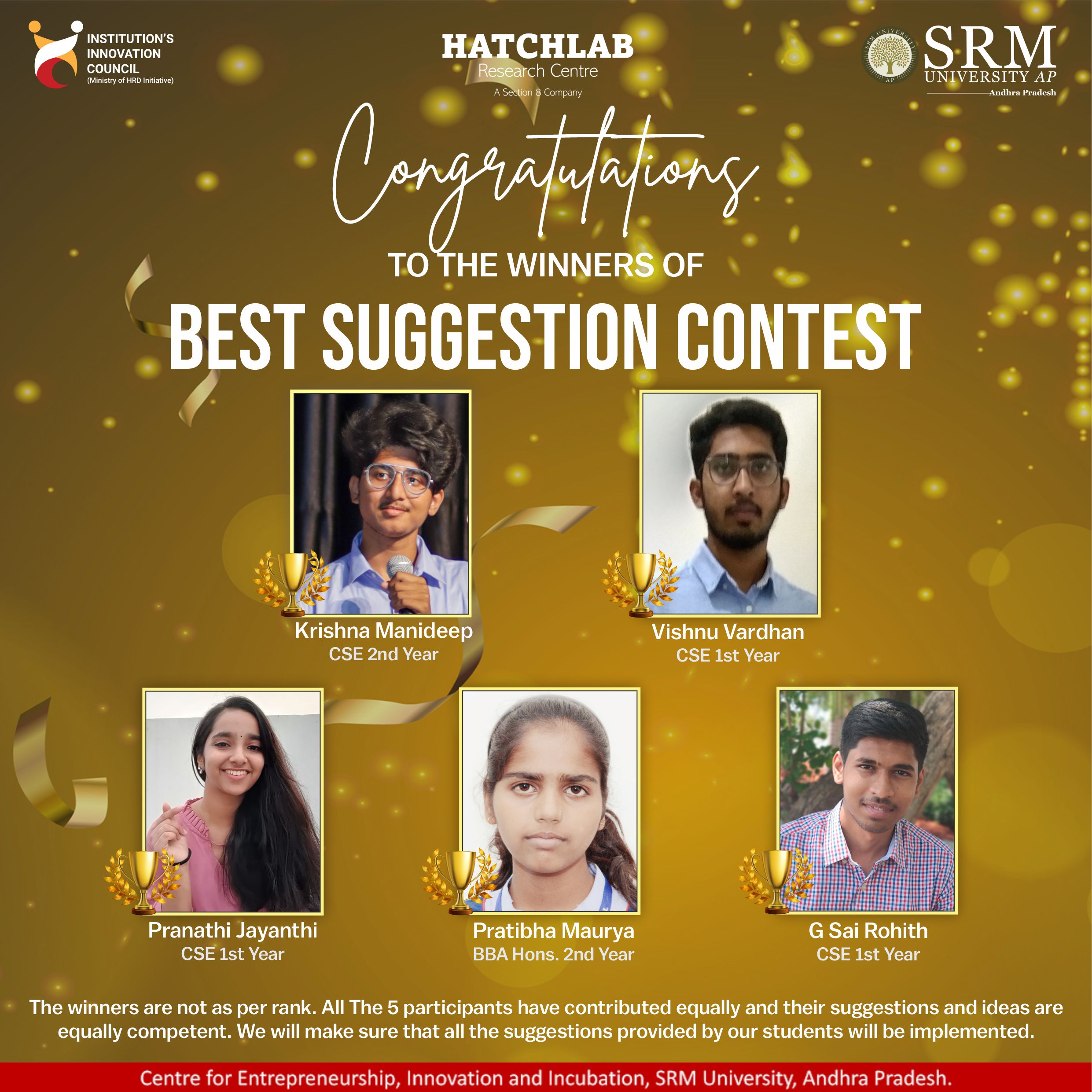 Innovative suggestions create a doorway to a world of opportunities and possibilities. The Suggestion contest conducted by the Department of Entrepreneurship and Innovation received 206 entries, and each of them was significant in one way or the other. Finding out the most impactful and meaningful suggestions among them was a hectic task, and we have five winners for the competition. Congratulations to CSE second-year student Krishna Manideep, BBA second-year student Pratibha Maurya and CSE first-year students; Vishnu Vardhan, Pranathi Jayanthi, and G Sai Rohith for making it to the top five.
Innovative suggestions create a doorway to a world of opportunities and possibilities. The Suggestion contest conducted by the Department of Entrepreneurship and Innovation received 206 entries, and each of them was significant in one way or the other. Finding out the most impactful and meaningful suggestions among them was a hectic task, and we have five winners for the competition. Congratulations to CSE second-year student Krishna Manideep, BBA second-year student Pratibha Maurya and CSE first-year students; Vishnu Vardhan, Pranathi Jayanthi, and G Sai Rohith for making it to the top five.
The department has started programmes like “ExplorerHive” and “the Leader” based on the suggestions of students. Many more innovative programs are yet to come by utilising the suggestions obtained through the competition. Congratulations to the whole 206 participants for their contributions and suggestions. We value each of you and your suggestions and will try our best to put them all into practice.
- Published in IDEA NEWS, News, Students Achievements
Faculty Development Programme on Optical Communication and Wireless Networks
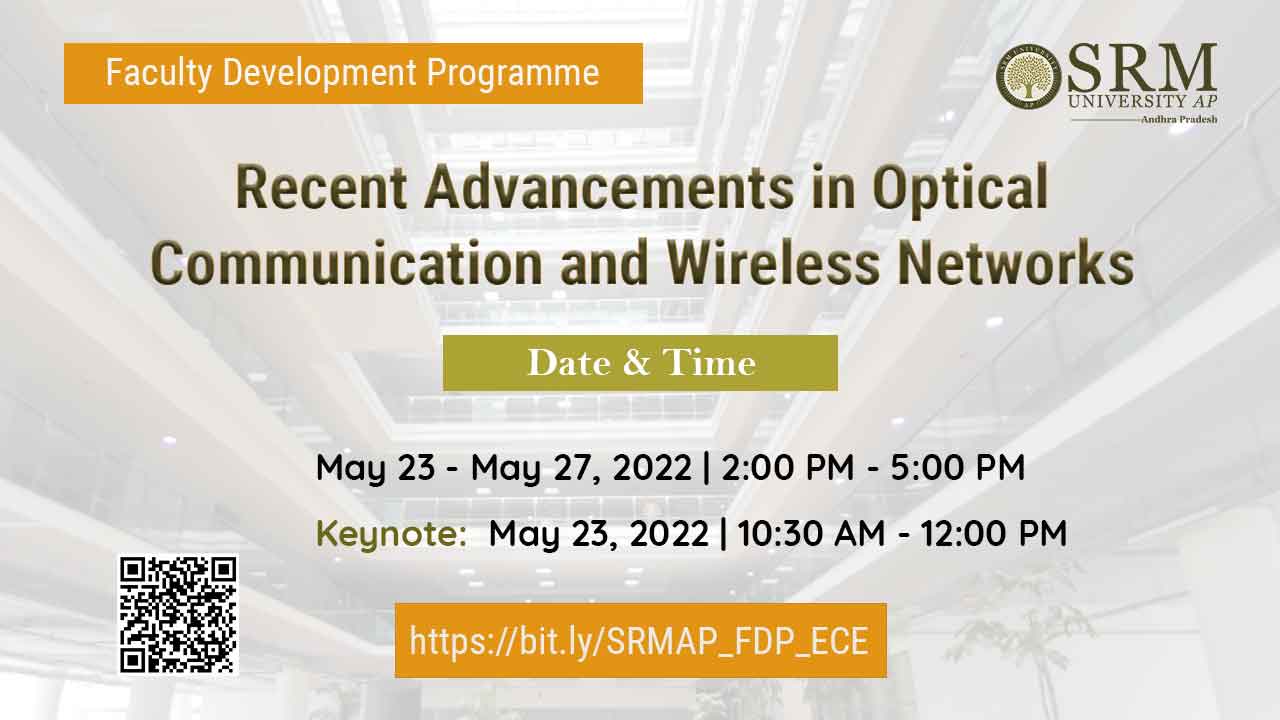 SRM University AP is delighted to announce the Faculty Development Programme on Recent advancements in optical communication and wireless networks. The session is scheduled from May 23 to 27, 2022. The programme will be managed by the faculties of the Department of Electronics and Communication Engineering. This five-day hybrid programme aims to enhance research capabilities mainly for the researchers and professionals working in Free Space Optics and Advanced Wireless Communication Networks. Eminent scientists and professors from highly reputed institutes are invited to share their research experiences.
SRM University AP is delighted to announce the Faculty Development Programme on Recent advancements in optical communication and wireless networks. The session is scheduled from May 23 to 27, 2022. The programme will be managed by the faculties of the Department of Electronics and Communication Engineering. This five-day hybrid programme aims to enhance research capabilities mainly for the researchers and professionals working in Free Space Optics and Advanced Wireless Communication Networks. Eminent scientists and professors from highly reputed institutes are invited to share their research experiences.
On the first day of the session, the keynote speaker, Professor M.S Alouini, KAUST, Saudi Arabia, will handle a session on Towards Connecting the Remaining 3 + Billion from 10.30 am to 12.00 pm. The FDP targets faculties from Abroad and Indian Institutes, Research scholars, Postgraduate and Undergraduate students. The sessions will be beneficial to those participants who are doing or planning to start a research career in optical/wireless communication network domains.
A wide variety of topics will be discussed during the five-day program. Visible light communication, Optical Imaging and Holography, Computational Optical Sensing and Imaging, VLC for IoT Networks, Terahertz Photonics for Wireless Communications, Deep learning for Wireless Networks, Intelligent Reflecting Surfaces, Edge Computing for IoT Networks, Beyond 6G Communications and Molecular Communications are some of the crucial ones among them.
There is no registration fee for the programme. However, the certificate will be provided to all the attendees based on the total attendance. The recordings of the sessions will also be provided to all attendees.
- Published in Departmental Events, ECE Events, Events
A solar-powered innovation of Venkata Sree Harsha
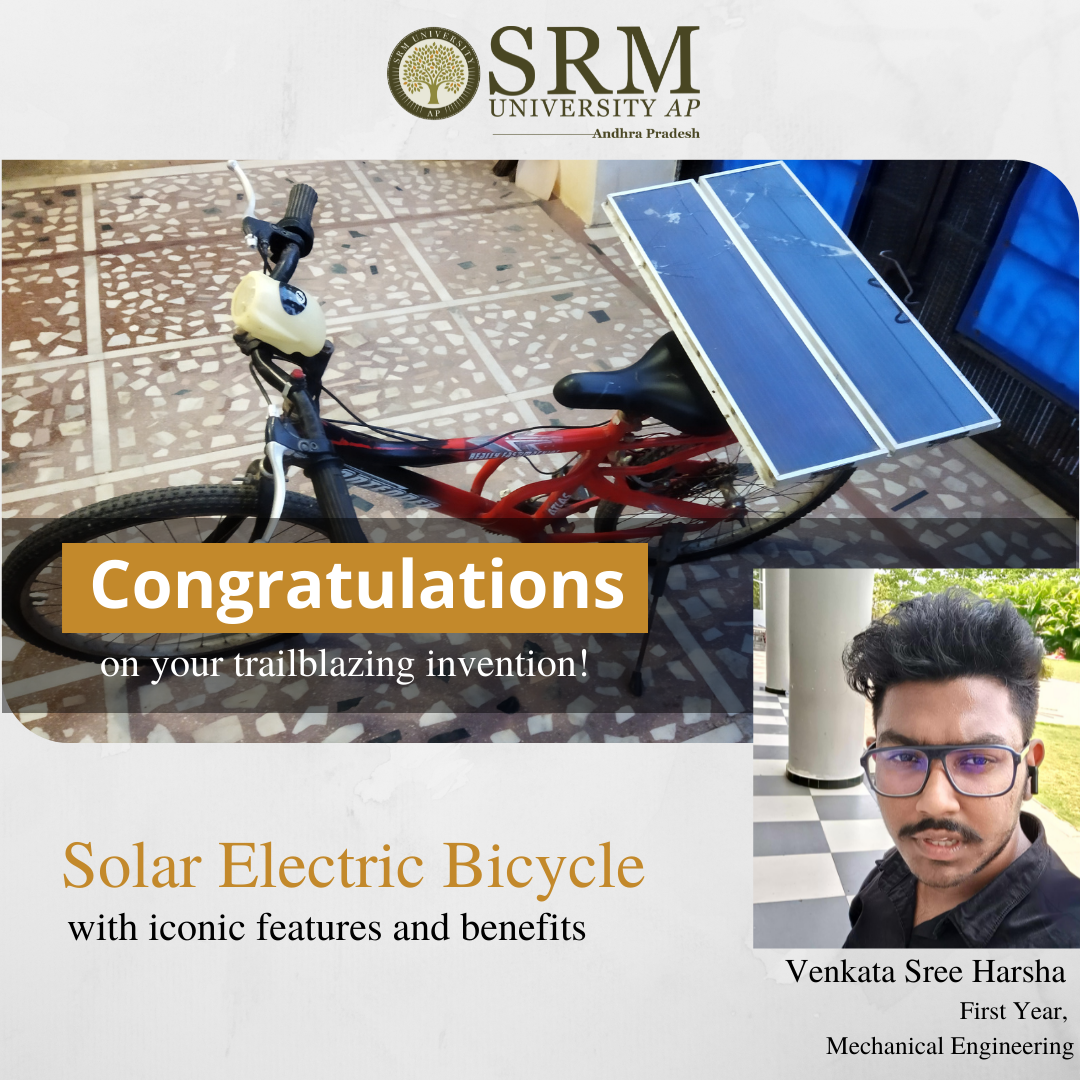
Student innovations that render hope and reassurance to an ever-changing society with booming demands indeed call for sweeping appreciation and recognition. We are elated to present the story of one of our budding masterminds who has brought us laurels through his trailblazing invention. Our first-year Mechanical Engineering student, Venkata Sree Harsha has developed the prototype of a solar electric bicycle with iconic features. This is a well-timed invention presented in the face of exacerbating pollution and energy insufficiency.
There have been endless studies and research going on to discover alternate solutions to bring down the imprudent use of conventional sources of energy. We are running out of our resources on one hand, and they are causing irreversible damage to the environment on the other hand. Tapping the invaluable potential of solar energy is the ideal way to welcome a new era of renewable energy resources. Solar inventions are therefore encouraged and put to implementation. This is believed to expedite the use of such renewable resources.
Venkata Sree Harsha’s solar-powered bicycle can run for unlimited distance in sunlight and for 2 hours at night when fully charged. It is fitted with a 24 Volt, 350-Watt DC motor, two 12 Volt batteries, two 6-Watt solar panels, and other components. The rechargeable batteries are attached to a 36 Volt motor, and it is connected in a series fashion. The solar power panels are fastened to the rear end of the vehicle which actively charges the bicycle while it is running on the sun. The total investment for this environment-friendly solar bicycle came approximately to rupees 15,000. This is a fruitful innovation when the escalating fuel prices are causing hardships in an average Indian household.
The young innovator expressed his delight and contentment over making his tiny share of contribution to the lives of those who are struggling to make ends meet in a world where expenses are soaring high without limits. His passion for science and determination to bring technology to right and productive use are what made this innovation possible. Mr Venkata also thanked his teachers and fellow friends who helped and guided him throughout this rewarding journey.
- Published in Departmental News, Mechanical Engineering NEWS, News, Students Achievements
Towards green whiskey production
Dr Karthik Rajendran, Assistant Professor from the Department of Environmental Science, has added another paper to his list of publications. His paper titled Towards green whiskey production: anaerobic digestion of distillery by-products and the effects of pretreatment has been published in the Journal of Cleaner Production (Q1 category) with an impact factor of 9.2.
Abstract of the research
 Using renewable biogas from anaerobic digestion of distillery by-products as a low carbon heat source can decarbonise the distillery process and support the distillery industry for a transition to a more sustainable production process. The study investigated the anaerobic digestion performance of different types of whiskey by-products and the effects of acid pre-treatment on the digestion of solid by-products. Results of biomethane potential assays showed that the methane yield from the unprocessed by-products was 330 mL/g volatile solids (VS) from draff, 495 mL/g VS from thin stillage, and 503 mL/g VS from thick stillage. For the processed by-products, the specific methane yield was 370 mL/g VS from cake maize, 382 mL/g VS from wet distillers’ grains with solubles (WDGS), and 545 mL/g VS from syrup. Acid pre-treatment (1% H2SO4 at 135 ◦C for 15 min) did not significantly improve the methane yield from solid by-products (such as draff and WDGS) but reduced the digestion time by 54.5% for cake maize. The microbial community analysis revealed that methane production from the untreated and acid-pre-treated solid by-products (draff and WDGS) was mainly through the hydrogenotrophic methanogenesis pathway. The gross thermal energy in the form of methane produced from 100 tonnes of mixed unprocessed by-products (draff, thin stillage, and thick stillage) was calculated as 24.4 MWthh equivalents to 60.6% of the thermal energy consumed in whiskey production, which affected the same percentage of CO2 emissions reduction.
Using renewable biogas from anaerobic digestion of distillery by-products as a low carbon heat source can decarbonise the distillery process and support the distillery industry for a transition to a more sustainable production process. The study investigated the anaerobic digestion performance of different types of whiskey by-products and the effects of acid pre-treatment on the digestion of solid by-products. Results of biomethane potential assays showed that the methane yield from the unprocessed by-products was 330 mL/g volatile solids (VS) from draff, 495 mL/g VS from thin stillage, and 503 mL/g VS from thick stillage. For the processed by-products, the specific methane yield was 370 mL/g VS from cake maize, 382 mL/g VS from wet distillers’ grains with solubles (WDGS), and 545 mL/g VS from syrup. Acid pre-treatment (1% H2SO4 at 135 ◦C for 15 min) did not significantly improve the methane yield from solid by-products (such as draff and WDGS) but reduced the digestion time by 54.5% for cake maize. The microbial community analysis revealed that methane production from the untreated and acid-pre-treated solid by-products (draff and WDGS) was mainly through the hydrogenotrophic methanogenesis pathway. The gross thermal energy in the form of methane produced from 100 tonnes of mixed unprocessed by-products (draff, thin stillage, and thick stillage) was calculated as 24.4 MWthh equivalents to 60.6% of the thermal energy consumed in whiskey production, which affected the same percentage of CO2 emissions reduction.
Explanation of the research
Many industries meet their energy demand based on the fossil fuels such as coal, oil, and natural gas, which increases carbon dioxide emissions. Alcohol production is one of the heavy fossil fuel using industries, especially in distillation. The waste after alcohol production can be used to produce methane, which can be used as energy in distillation, reducing the need for energy consumption. By consuming the waste and producing energy, up to 60% of thermal energy could be reduced. This also reduces the CO2 emission by 60%. Alcohol industries can use their waste to decarbonise the energy demand, thus meeting the net-zero. India is expected to reach net-zero by 2070, which will be a bigger addition as a part of it.
In this research, Dr Karthik Rajendran has collaborated with Professor Jerry Murphy, UCC, Ireland, and Dr Richen Lin, UCC, Ireland. Applying the similar concept in the Indian context is his future plan for this research.
- Published in Departmental News, ENVS News, News, Research News
Dr Anu Kuriakose bestowed with CM’s Nava Kerala Research Fellowship
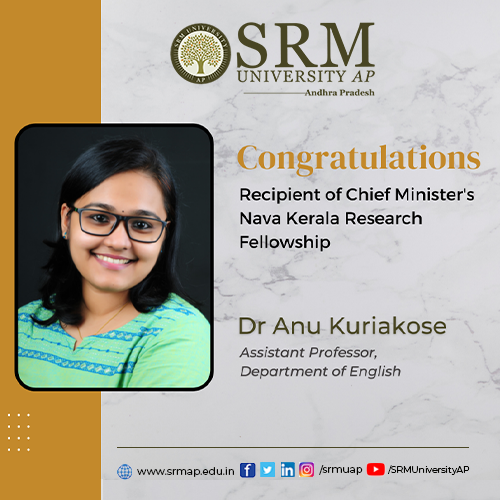
The Government of Kerala has chosen Dr Anu Kuriakose from the Department of English for the prestigious Chief Minister’s Nava Kerala Research Fellowship in the stream of Political Science, Historical Studies, Humanities & Liberal Arts. The award has been designed by Kerala Government to further the state’s development plans by promoting research across various disciplines. Dr Anu obtained the grant for her intriguing study in the domain of gender studies. She intends to look at the digital turn in the genderqueer movements in Kerala with a cross-cultural perspective from any specific locale in Europe.
There have been many research studies involving the examination of queer and trans representation in media. With the turn of the century, we witnessed a remarkable shift in the digital representation of the queer community.
Through her research “Dissenting Heteronormativity and Mainstreaming Identity: A Critical Assessment of the Digital Turn in GenderQueer Movements in Kerala”, Dr Anu is fixated on uncovering the digital collectives in which Malayali genderqueer people are also a part of and the digital turn in the genderqueer movement in Kerala, of late.
She expressed her delight over receiving this opportunity that could help her make substantial contributions to the state’s progress. “I feel proud and humbled for getting this title; my project aims to map the genderqueer movements, the digitally networked associations of which Malayali gender non-conforming people are part, and the nuances of their digital turn at present”, she said.
The Department of English, University of Calicut, has agreed to be a hosting centre for the research project. The GEXcel International Collegium for Advanced Transdisciplinary Gender Studies, Karlstad University Sweden, has also agreed to collaborate. She also wishes to make SRM University-AP a stakeholder in the same.
“I am hugely motivated by the weight SRM University-AP gives to research. From making collaborations to publishing papers in reputed journals and receiving grants from external bodies, the university has anchored as an encouraging platform to stimulate the research pursuits of its faculty and students”, she maintained. “I am truly indebted to my peers and everyone here for providing a conducive environment to fructify my research interests”, remarked Dr Anu.
- Published in Departmental News, English Current Happenings, English news, Faculty Achievements, News, Research News

